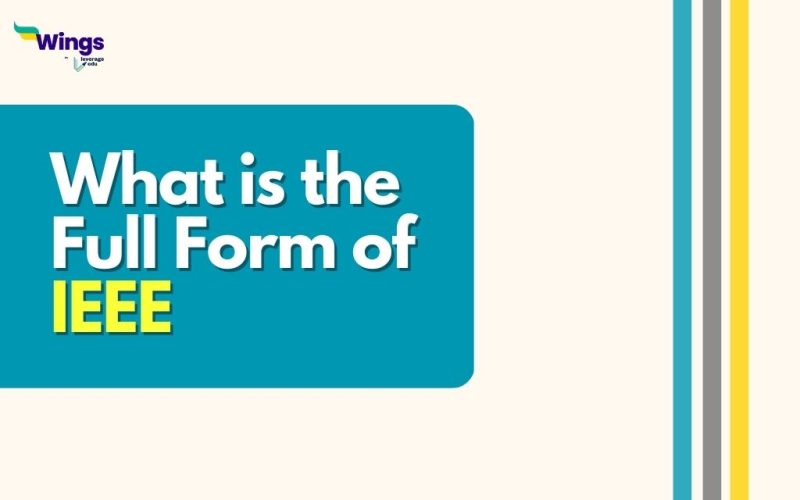The full form of IEEE is the Institute of Electrical and Electronics Engineers. It is a professional association for electronics engineering, electrical engineering, and other related disciplines in Engineering.
The IEEE was founded through the union of the American Institute of Electrical Engineers and the Institute of Radio Engineers in 1963. Its headquarters are located in New York, United States. It is the world’s largest association of technical professionals. The goal of IEEE is to empower academic and technical advancement of electrical and electronics engineering, telecommunications, computer engineering, and other related disciplines.
History of IEEE
- In 1884, a small group of electrical professionals founded the American Institute of Electrical Engineers (AIEE for short).
- In 1912, the IRE (Institute of Radio Engineers) was founded as a new industry of wireless telegraphy.
- The IRE grew quicker than the other societies, eventually becoming the biggest group in 1957.
- On January 1, 1963, the IRE and the AIEE combined to establish the IEEE. At its inception, the group had 150,000 members, 140,000 of whom lived in the United States.
- Further, IEEE grew in popularity in the decades that followed. By the early twenty-first century, it had expanded to 39 Societies, 130 journals, transactions, and magazines, 900 active standards, and over 300 conferences every year.
- By 2020, IEEE will have approximately 395k members from 160 countries.
Characteristics of IEEE
- IEEE is led by a group of appointed and elected volunteers. They represent members from ten geographical regions throughout the world, as well as 46 Societies and Technical Councils.
- 39 societies cover a wide range of technical issues, with each focused on a certain topic.
- IEEE provides a variety of programs to recognize educational, industry, research, and service achievements.
- Every year, it hosts around 300 conferences.
- There are currently 900 active standards, with another 700 in the works.
- IEEE publishes 30% of the computer, electrical engineering, and control technology literature.
Benefits of IEEE
- Their data transmission system is far faster than the pace of their conveyance.
- Its multi-path propagation increases the transmission rate while decreasing error incidence.
- Manual adjustment of the transmission’s modulation.
- Additionally, IEEE is an organization that creates standards for the electronic and computer industries.
- IEEE, as a non-profit professional organization, seeks to advance humanity.
Limitations of IEEE
- There have been allegations of unlawful usage among persons.
- IEEE standards necessitate regular and proper upkeep.
- The network security must be strong.
- IEEE 802.11 suffers from traffic disturbances.
- Lastly, Wi-Fi-enabled devices can detect any data transmission over radio waves in the vicinity.
IEEE Key Subjects
The following are the key subjects that IEEE primarily focuses on:
- Information Technology
- Electronics and Communication Engineering
- Electrical Engineering
- Computer Engineering
IEEE Goal
The IEEE was founded by a group of talented engineers dedicated to encouraging technological advancement for raising the standard of living. Being a non-profit group, IEEE works on improving specialized tools and services. Hardworking engineers at IEEE work from dusk till dawn to create scientific applications to improve human existence in today’s time
IEEE Functions
The IEEE offers various learning opportunities within the engineering sciences, research, and technology as a stepping stone to improve the educational advancement of electronic engineering. In addition, the educational facilities are as follows:
- IEEE eLearning Library
- Education Partners Program
- Standards in Education
- Continuing Education Units
IEEE also produces literature in the electrical, electronics, and computer engineering fields. It has been published in 200 peer-reviewed journals.
IEEE has 39 technical societies, each focusing on a particular knowledge area. These technical societies also offer specialized publications, conferences, and business networking.
How to Join the IEEE?
There are different requirements for professionals and students.
| Professionals | Open to individuals who are experienced to give direct competence in an IEEE-designated field |
| Students | Must obtain at least 50% of a normal full-time academic program as a registered UG or graduate student in a full-time course of study in IEEE-designated fields |
Please note that the designed fields are
- Engineering
- Computer Sciences and Information Technology
- Physical Sciences
- Biological and Medical Sciences
- Mathematics
- Technical Communications
- Education
- Management
- Law and Policy
You may also read:
All about Electrical and Electronics Engineering
How to Become an Electrical Engineer?
Hope this helped you understand the IEEE full form. To know other useful information, please visit our page now! Or if you wish to pursue Engineering abroad then feel free to reach out to Leverage Edu.
 One app for all your study abroad needs
One app for all your study abroad needs














 45,000+ students realised their study abroad dream with us. Take the first step today.
45,000+ students realised their study abroad dream with us. Take the first step today.

